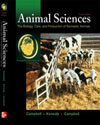
The Physiology of Digestion in Nutrition |  |
Chapter Summary| All animals depend directly or indirectly on plants for their supply of nutrients. The digestive system of each species is adapted to the kind of feeds normally consumed. Ruminants possess a complex digestive system consisting of four stomach compartments in which microorganisms help in digesting cellulose and other fibrous plant compounds that cannot be broken down by the animal's own digestive enzymes. This enables them to utilize large quantities of forages. Other species such as swine and poultry consume larger proportions of grains and other concentrates and depend almost entirely on digestive enzymes to chemically break down the nutrients in these feeds.
Foods must be broken down into simpler compounds before they can be absorbed into the bloodstream where they are used for maintenance energy; body repair; growth of new tissues; reproduction; work; and the production of meat, milk, eggs, and wool. In the processes of digestion, absorption, and utilization many plant nutrients are lost to the animal for productive purposes. Although animals are somewhat inefficient converters of plant nutrients into animal products they possess digestive systems designed to enable them to serve as "middlemen" in converting many plants (especially those containing large amounts of cellulose, which is not utilized by humans) into animal products useful to the health and nutrition of humans.
|
|
|